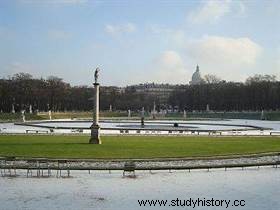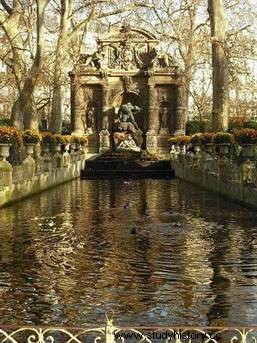 If we benefit nowadays from the magnificent garden that is the Jardin du Luxembourg in the 6th arrondissement of Paris, it is thanks to Marie de Médicis and her Italian taste. Loving this quiet neighborhood, she decided to acquire a piece of land large enough to build a palace and a garden in the Florentine style. Very popular with artists, men of letters, this garden is conducive to strolling, resting, daydreaming .... and this, for a whole day.
If we benefit nowadays from the magnificent garden that is the Jardin du Luxembourg in the 6th arrondissement of Paris, it is thanks to Marie de Médicis and her Italian taste. Loving this quiet neighborhood, she decided to acquire a piece of land large enough to build a palace and a garden in the Florentine style. Very popular with artists, men of letters, this garden is conducive to strolling, resting, daydreaming .... and this, for a whole day.
The Luxembourg Gardens, the work of Marie de Medici
After the assassination of her husband Henri IV, the queen left the Louvre. Some members of his family already resided in his future quiet, worldly and despite everything rural neighborhood. In 1612, she bought the hotel from Duke François de Luxembourg, then other land until 1631, when she was exiled by her son Louis XIII.
 The land belonged to the Carthusian convent, on an area of about twenty-five hectares, at the limits of the gates Saint Michel and Saint Germain, on the left bank of the Seine. The Carthusians not wanting to give anything up, this garden is different from those generally built facing the palaces:opposite the facade, it is only two hundred meters long. The queen will therefore extend it on one side. Wishing for fountains and basins, she called on the “Francine” engineers who would perform wonders on the water jets of Versailles. The Fountain of Medici was built in 1620, certainly by Thomas Francine, and represents Leda seated on the banks of the Eurotas near Jupiter transformed into a swan. Chalgrin had it repaired after the Revolution, and had a Venus installed in the center. The central basin in front of the palace is surrounded by two raised promenades, in order to better admire the jets below. André Le Nôtre participated in the creation of the parterres surrounding the basin, until the death of the queen in 1642.
The land belonged to the Carthusian convent, on an area of about twenty-five hectares, at the limits of the gates Saint Michel and Saint Germain, on the left bank of the Seine. The Carthusians not wanting to give anything up, this garden is different from those generally built facing the palaces:opposite the facade, it is only two hundred meters long. The queen will therefore extend it on one side. Wishing for fountains and basins, she called on the “Francine” engineers who would perform wonders on the water jets of Versailles. The Fountain of Medici was built in 1620, certainly by Thomas Francine, and represents Leda seated on the banks of the Eurotas near Jupiter transformed into a swan. Chalgrin had it repaired after the Revolution, and had a Venus installed in the center. The central basin in front of the palace is surrounded by two raised promenades, in order to better admire the jets below. André Le Nôtre participated in the creation of the parterres surrounding the basin, until the death of the queen in 1642.
Different owners
From this date, the property passes through various hands and does not change in appearance. The garden remains as it is until the whole is passed on to the Count of Provence, brother of Louis XVI. To pay for the renovation work on the palace, part of the land was sold (the western part), then in 1782 when Paris decided to make a hole in the rue du Luxembourg, ten hectares were sold. But during the Revolution, the garden was once again abandoned, the palace serving as a prison. The positive point, despite everything, is that the Chartreux convent being requisitioned, the garden could be extended again, as far as the Observatory, a plot whose end almost touches the Boulevard du Montparnasse. The alley of the Observatory is thus created. Napoleon turned it into a garden for children, with play areas and gazebos.
The park was trimmed again, when Haussmann made arrangements to build rue Vaugirard and boulevard Saint Michel. The garden is limited to the south by a lane in the extension of the rue de l'Abbé de l'Epée, the nursery and the botanical garden are located in this southern part. But new works are planned in 1865 and despite the petition of twelve thousand signatures to oppose it, they are implemented.
Among these works, the Fountain of Medici is concerned. First called the Luxembourg cave, it was moved in 1862, dismantled stone by stone, reduced and brought closer to the palace. The appearance has not changed:in front of the fountain, a long basin is filled with water, surrounded by two rows of trees and decorated with flowered basins.
 Maupassant says in one of his tales:"It was like a forgotten garden from the other century , a garden as pretty as an old lady's sweet smile. Bushy hedges separated the narrow and regular paths, calm paths between two walls of foliage trimmed with method. The gardener's large scissors relentlessly lined up the partitions of branches; here and there one came across flowerbeds, flowerbeds of small trees arranged like schoolboys on a walk, societies of magnificent roses and regiments of fruit trees”.
Maupassant says in one of his tales:"It was like a forgotten garden from the other century , a garden as pretty as an old lady's sweet smile. Bushy hedges separated the narrow and regular paths, calm paths between two walls of foliage trimmed with method. The gardener's large scissors relentlessly lined up the partitions of branches; here and there one came across flowerbeds, flowerbeds of small trees arranged like schoolboys on a walk, societies of magnificent roses and regiments of fruit trees”.
These gardens, much sought after by Parisian walkers, were used as parking lots during the Second World War! What a misfortune for the superb statues installed. During the walk, we notice the former queens and illustrious ladies around the pool:Marie Stuart, Jeanne d'Albret, Blanche de Castille, the Grande Mademoiselle (de Montpensier), Anne of Austria; but also further back in the gardens, statues of artists such as Georges Sand, Stendhal, Baudelaire, Beethoven, Stefan Zweig, Delacroix; antiques decorate the edges of the paths:the dancing faun, David victorious over Goliath, Venus emerging from the bath; then more stelae:the Memorial to the Resistance, the Nubian Lion and its prey...
The Luxembourg Gardens
The twenty-three hectare property also includes a fruit garden, greenhouses, a collection of orchids and around forty thousand trees and shrubs, some of which are classified as Remarkable .
Thanks to a Carthusian brother from Paris, the orchard was born around 1650 and more than fourteen thousand fruit trees came out of the estate around 1712. Thanks to the members of this congregation in Europe who obtained different varieties of fruits, a beautiful collection of fruits from all over the world is born. The Revolution leaves its passage here too, the property of the clergy is nationalized, the nursery gradually disappears. It was only thanks to Napoléon Premier that the fruit collection relocated to the square. Today, it has more than a thousand trees and brings together about three hundred and eighty varieties of apples and two hundred and fifty pears. This garden, officially recognized as a “conservatory orchard” in 1991, is also used for classes at the Luxembourg Gardens School of Horticulture.
The greenhouses of the garden are used for the production of flowers for the floral decoration of the Palace as well as the embellishment of the gardens, and this since shortly after the Revolution in 1796. Currently, d an area of three thousand six hundred square meters, they include the orangery and a collection of orchids.
 The current orangery, located in the western part, dates from 1839 and houses around two hundred crate plants among which are bitter oranges (bigaradiers) two hundred and fifty to three hundred years old, date palms, oleanders, pomegranates. In fine weather, some of these plants are displayed along the facade of the Palace. Repotting takes place regularly, every twelve to fifteen years for orange trees and every seven to eight years for palm trees, the wood of the crates rotting and the roots protruding from the wooden panels.
The current orangery, located in the western part, dates from 1839 and houses around two hundred crate plants among which are bitter oranges (bigaradiers) two hundred and fifty to three hundred years old, date palms, oleanders, pomegranates. In fine weather, some of these plants are displayed along the facade of the Palace. Repotting takes place regularly, every twelve to fifteen years for orange trees and every seven to eight years for palm trees, the wood of the crates rotting and the roots protruding from the wooden panels.
When around 1830 the Faculty of Medicine in Paris received orchids from Brazil, they thought of creating an entire collection. Thus since 1838, collectors have been exchanging plants, the practice is developing to reach one thousand two hundred species. The Senate agreed to take over the collection in 1859, when the garden of the Faculty of Medicine was closed, and had a greenhouse specially built. The collection recognized as the “national collection” now brings together more than ten thousand pots belonging to one hundred and fifty genres. They can be admired during the European Heritage Days in September each year.
During the walk we are surprised by majestic trees, crooked, but very valuable. Some date from the beginning of the nineteenth century, others may have known Marie de Medici. Among the best known, we find the Red Pavia, the Silk Tree (acacia), the Hackberry of Provence, the Judas Tree, the Handkerchief Tree, the Mulberry, the Sequoia, the Purple Beech. At their feet, we discover an enamelled plaque mentioning their origin, their Latin name and their particularities.
To go further
- Knowledge of Old Paris – Jacques Hillairet – Rivages 2005
- The Senate Gardens website
